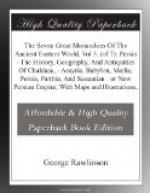In the matter of personal ornaments the taste of the Persians seems to have been peculiarly simple. Earrings were commonly plain rings of gold; bracelets mere bands of the same metal. Collars were circlets of gold twisted in a very inartificial fashion. There was nothing artistic in the sheaths or hilts of swords, though spear-shafts were sometimes adorned with the representation of an apple or a pomegranate. Dresses seem not to have been often patterned, but to have depended generally for their effect on make and color. In all these respects we observe a remarkable contrast between the Arian and the Semitic races, extreme simplicity characterizing the one, while the most elaborate ornamentation was affected by the other.
Persia was not celebrated in antiquity for the production of any special fabrics. The arts of weaving and dyeing were undoubtedly practised in the dominant country, as well as in most of the subject provinces, and the Persian dyes seem even to have had a certain reputation; but none of the productions of their looms acquired a name among foreign nations. Their skill, indeed, in the mechanical arts generally was, it is probable, not more than moderate. It was their boast that they were soldiers, and had won a position by their good swords which gave them the command of all that was most exquisite and admirable, whether in the natural world or among the products of human industry. So long as the carpets of Babylon and Sardis, the shawls of Kashmir and India, the fine linen of Borsippa and Egypt, the ornamental metal-work of Greece, the coverlets of Damascus, the muslins of Babylonia, the multiform manufactures of the Phoenician towns, poured continually into Persia Proper in the way of tribute, gifts, or merchandise, it was needless for the native population to engage largely in industrial enterprise.
To science the ancient Persians contributed absolutely nothing. The genius of the nation was adverse to that patient study and those laborious investigations from which alone scientific progress ensues. Too light and frivolous, too vivacious, too sensuous for such pursuits, they left them to the patient Babylonians, and the thoughtful, many-sided Greeks. The schools of Orchoe, Borsippa, and Miletus flourished under their sway, but without provoking their emulation, possibly without so much as attracting their attention. From first to last, from the dawn to the final close of their power, they abstained wholly from scientific studies. It would seem that they thought it enough to place before the world, as signs of their intellectual vigor, the fabric of their Empire and the buildings of Susa and Persepolis.




